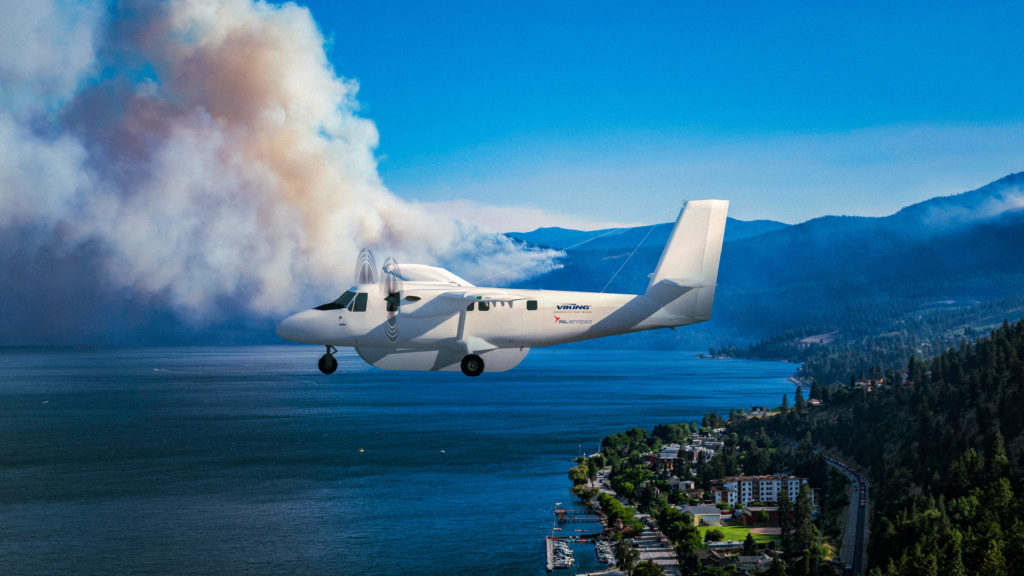Estimated reading time 8 minutes, 34 seconds.
In a world where wildfires have grown in size, intensity, and frequency, every tool in the toolbox counts.
That’s the premise behind a new aerial firefighting system (AFFS) being developed by Viking Air and PAL Aerospace – a solution that will equip the trusty DHC-6 Twin Otter to fight wildfires.
The two Canadian companies joined forces in April to develop the Twin Otter Fire Attack System, which will allow the aircraft to transition easily from a passenger/cargo transport to an aerial firefighting asset.

Dan Seroussi, director of programs at Viking, headquartered in Sidney, British Columbia, told Skies the AFFS concept was driven by a customer order, as an option for their new Series 400 Twin Otter.
“We already had the idea in our mind,” he said. “We wanted to do it for the Twin Otter. The customer request was one thing, but we wanted to improve on the legacy design, to make sure we had a concept that made sense – to provide retardant, but keep the functionality of the aircraft so it could easily be returned to its original configuration.”
Viking is no stranger to fighting wildfires, as it holds the type certificate for all Canadair amphibious firefighting aircraft. Its sister company, De Havilland Aircraft of Canada Limited, is also actively involved in aerial firefighting with its Dash 8-400. Viking is now working to improve its fleet offerings with new platform variants such as the CL-415EAF and CL-515.
The OEM approached St. John’s, Newfoundland-based PAL Aerospace, an experienced operator and modifier of the DHC-6 Twin Otter — with nine of the type currently in its fleet.
“PAL was the ideal partner for this project, and together we defined the final requirements,” said Seroussi.
Although the customer originally wanted an interior tanking system, he said a complete analysis indicated that an external tank would optimize water flow and drop pattern, and allow for the interior to be open for cargo and/or passengers.
In collaboration with Viking, PAL will provide the design, engineering, airworthiness, and kit required to obtain a supplemental type certificate (STC) used to modify legacy DHC-6-300 and new Series 400 models with the AFFS.
When equipped for aerial firefighting, the Twin Otter will carry an external belly tank capable of holding 6,000 pounds of fire retardant. According to PAL, retardant delivery will be greater than 1,200 pounds per second, and the full load will drop in approximately six seconds.
Viking and PAL will offer the Twin Otter AFFS with two sub-kit options: an “A” kit, which will be fixed and remain installed during all non-firefighting operations; and a “B” kit, which is external, removable, and required for aerial firefighting. The advantage of removing the “B” kit is the reduction in weight, which would allow the aircraft to return to its original configuration when not fighting fires.
Benjamin Boehm, senior vice president at PAL Aerospace, told Skies the beauty of the system is that inherent flexibility.
“It’s removable, so one day the aircraft can carry 19 passengers and then after that it can have tanks installed and do aerial firefighting,” he said. “It will take four hours to install the B kit after initial installation.”
The new system will necessitate a maximum takeoff weight (MTOW) increase for the DHC-6-400 to 15,500 pounds, permitting operations under Transport Canada’s restricted operations category for aerial firefighting. When the kit is removed, the aircraft will revert back to normal category operations (12,500-lb MTOW) for the transportation of passengers and cargo. Viking expects the numbers to be similar for the legacy 300 model.
Major components will include a modular water tank composed of a carbon fibre foam/water reservoir and a liquid retardant tank and transfer system, along with fairings and the fuselage attachment system. To preserve ground clearance, the Twin Otter will be equipped with high flotation tires and PAL rim extenders on the main landing gear. Tanks can be refilled through a single point external filling and sight gauge system.
“The Twin Otter is a STOL (short takeoff and landing) aircraft,” said Boehm. “With those big balloon tires, it can land on rough strips and refill water/retardant from remote locations, allowing more rotations per day.”
He added that PAL is currently in the middle of engineering design work for the project.
“Early supply chain work has started and early drawings have gone to suppliers,” he said. “Longer term, it will enter into service in the second or third quarter of next year.”
PAL or Viking can install the kit, or it can be shipped to a customer for installation at their facility. The two companies will also offer validation support to obtain the necessary approvals from international airworthiness authorities.
“This is a great example of industry partnership,” said Viking’s Seroussi. “The initial requirement was done by Viking, and the STC belongs to PAL for design, installation, and modification. Viking will be involved as the OEM to support customers.”
He said the manufacturer has already fielded a number of inquiries about the Twin Otter Fire Attack System since a press release was issued in early August.
“Just imagine it as a new tool, so any firefighting agency in the world, they can call on Twin Otter operators,” said Boehm. “The most important thing for the Twin Otter is the 600- to 700-gallon drop capacity, and it’s able to land on short runways and at remote locations.”
The same Twin Otter Fire Attack System kit will fit both legacy airframes as well as new Series 400 models, although it is currently only for wheeled aircraft. Cost has not yet been determined.
The first converted aircraft will be delivered to an unnamed South American operator.
According to Viking, 138 Twin Otter Series 400s are operating with 60 companies around the world, while a further 375 DHC-6-300 models are flying with 140 operators.








